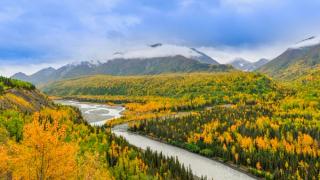SLR is a proud member of the Alaska Miners Association and sponsor of the 2025 AMA Annual Convention and Trade Show. SLR supports responsible mineral development and mining operations throughout Alaska and care deeply about Alaskan communities and Alaskan miners. Please join us at the 2025 Alaska Miners Association Annual Convention and Trade Show where this year's focus will be on "Unleashing Alaska's Strength: Resources. Resilience. Responsibility."
Stop by our booth (Booth #100) to meet our exceptional team of engineers and scientists and Alaskan experts listed below. Be sure to attend the Vendor Sessions from 3:30 - 5PM on Wednesday, November 5th, where Vincent Fricaud will be presenting an innovative approach to dispersion modeling in Southcentral Alaska.
SLR experts will be attending, including Jeremy Scott Collyard, Vincent Fricaud, Vesi Yakimova, Chris Lindsey, Stan Flagel, Heather Simon, Mark Turner, Leigh High, Tom Robbins, and Dave Sacco.
High‑Resolution Weather Research Forecast for Air Quality Dispersion Modeling in Southcentral Alaska
Wednesday, November 5, 2025
Southern Alaska’s steep terrain, complex coastlines, and cryosphere–ocean interactions pose challenges for mesoscale prediction and for the meteorological inputs required by regulatory air‑quality dispersion models. We configured a high‑resolution Weather Research and Forecasting (WRF) system to generate project‑specific meteorology supporting air quality dispersion assessments for a mining facility. The setup uses nested domains down to ~1–4 km over southern Alaska with regionally tuned geographic inputs (USGS terrain and land‑use/land‑cover, glacier/ice‑field extents, refined water/shoreline masks). Because near‑surface structure and shear critically influence plume rise, transport, and dilution, the vertical grid was densified within the planetary boundary layer (PBL)—increasing levels below ~2 km AGL and concentrating layers in the lowest 1,500 m—to better resolve stability transitions, low‑level jets, katabatic flows, and marine inversions relevant to stack‑height meteorology.
To quantify sensitivity to large‑scale forcing, parallel experiments were driven by NARR, ERA5, and HRRR while holding physics options fixed within each suite. Additional data‑assimilation (DA) configurations cycled conventional observations (surface METARs, marine platforms, and upper‑air soundings/ROAB; radiances where applicable) to improve initial conditions for boundary‑layer and precipitation processes. Model skill was evaluated against independent surface and upper‑air datasets using U.S. EPA‑recommended approaches for meteorological model performance (bias, RMSE, IOA/correlation; precipitation contingency metrics; diurnal/seasonal stratifications; case studies of gap‑wind and drainage events).
Results show that (i) region‑specific geographic inputs and targeted DA systematically improve near‑surface winds, temperature, and stability; (ii) enhanced vertical resolution in the PBL materially improves representation of low‑level shear, inversion strength, and plume‑relevant turbulence metrics; and (iii) higher‑resolution forcing (e.g., HRRR) sharpens mesoscale flows while broader reanalyses (e.g., ERA5) provide robust synoptic constraints. The workflow delivers defensible, dispersion‑ready meteorology for air‑quality modeling and establishes performance benchmarks for Alaska‑focused applications.
Learn more about our Air Quality team